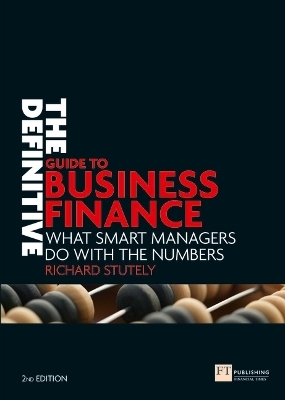
Definitive Guide to Business Finance, The
FT Publishing International (Verlag)
978-0-273-71095-0 (ISBN)
Many managers are extremely good at managing people but are bad at managing money, and harbour a secret fear of finance. But numbers matter and managers need to be confident with the basics of business finance – otherwise they simply can’t do their job effectively.
The Definitive Guide to Business Finance (previously titled The Definitive Guide to Managing Numbers) has been relaunched, revised and renamed. It includes a new introduction and has been updated throughout to keep in with the changing markets.Ittakes you step-by-step through every essential aspect of business finance you need to know. Assuming no specialised prior knowledge, it reveals shortcuts and tricks that will help make you a financial wizard whether it’s P&L, your budget, forecasts, cash flow, financial decisions, pricing policies or funding and financing.
In no time at all, you will not only be able to produce an outstanding set of figures, you will also have a much clearer understanding of what they mean and how to use them to be a more effective manager. You won’t fear finance ever again.
This is the only book on basic finance you'll need. Richard Stutely achieves what you might think is impossible: making finance fun with an amusing, wry and always common sense approach that will make you wonder what you ever worried about.
The Definitive Business Series will ensure you get up to speed fast with all the business essentials you need to be a success. With their guided step-by-step approach the latest practical business techniques and concepts and their easy-to-read style, The Definitive Business Series cover every aspect of the topic from the business basics to the essential skills needed to progress in your career.
The Definitive Business Series. Your fast-track to business success.
Businessman and author Richard Stutely has written many other books including The Economist Guide to Economic Indicators (1861974671 and has written extensively for publications such as The Economist, The Accountant and The Banker
Chapter 1. The Journey Starts Here Part 1. Attaining mastery over numbers First, I will help you suit up with the weapons and armour needed to do battle.
Chapter 2 Where Managers and Numbers Meet reviews this magical kingdom and starts to show you how to use the numbers to your advantage.
Chapter 3 How The Finance Director Thinks looks at mindset of the professionals with whom you will be dealing.
Chapter 4 The Financial Wizard's Toolbox investigates the tools you use to hammer the numbers – primarily spreadsheets.
Chapter 5 Taming Numbers – provides a refresher about some numerical techniques.
Patr 2. Managing moneySecond, now you are forearmed, we can move on to income and expenditure. I will show you how to dominate every penny that comes into and flows out of your coffers.
Chapter 6 Keeping Score reviews the rudiments of bookkeeping, with a special note on matters such as looking after the petty cash and dealing with expenses claims.
Chapter 7 How to Analyze Figures in the Fourth Dimension introduces ways of looking at how numbers have changed over time – and how this highlights what is happening to the business.
Chapter 8 How to Forecast Anything explains how to form a realistic view about potential future trends – with particular attention on forecasting sales.
Chapter 9 Getting to Gross Profit touches on broader aspects of sales revenue.
Chapter 10 Creating Capital considers the special factors surrounding capital spending (often huge outlays where there is longer-term benefit and perhaps short-term pain).
Chapter 11 Controlling Costs looks at other spending – the cash that seems to go up in smoke instantly when you pay telephone bills, rent, and so on.
Part 3. Doing the numbersNow you have a good understanding of number crunching techniques, as well as hands-on experience dealing with the figures that finance your business. You are now ready to pull them together for some serious business reporting, analysis and decision-making, and control.
Chapter 12 Brilliant Budgets reviews the budgeting process.
Chapter 13 Perfect Projects reveals the secrets of killer project management – feasibility studies, planning, decision and control. Good stuff applicable everywhere in surprising ways.
Chapter 14 Producing a Profit investigates income statements, known in the UK and elsewhere as profit and loss accounts. These are just budgets or project plans restated.
Chapter 15 Building a Balance Sheet looks at balance sheets – misunderstood (to say the least) medical reports about of the health of any business.
Chapter 16 Controlling Cash Flow considers sources and uses of funds – highlighting ways of re-casting the figures already dealt with to give you better management control over cash.
Part 4. Managing betterBy now, you are all set for success. Chapter 17 Seeing the Big Picture looks at how you pull all the components together – and how individual figures relate to and mesh with those of the enterprise as a whole. Chapter 18 Making Better Financial Decisions aim to help you do just that – covering questions such as how profitable is my business, which product lines are most profitable, and which business units are most vulnerable. Chapter 19 Managing the Numbers will let you manage financials better on a daily basis – with shortcuts to incisive analysis, tips for handling financial meetings, presentations and beanies, and so on. Chapter 20. When Things Go Wrong deals with the inevitable – what to do when things go wrong; things such as cost overruns, econom
| Erscheint lt. Verlag | 21.12.2006 |
|---|---|
| Reihe/Serie | Financial Times Series |
| Verlagsort | Harlow |
| Sprache | englisch |
| Maße | 171 x 238 mm |
| Gewicht | 738 g |
| Themenwelt | Wirtschaft ► Betriebswirtschaft / Management ► Finanzierung |
| Wirtschaft ► Betriebswirtschaft / Management ► Rechnungswesen / Bilanzen | |
| ISBN-10 | 0-273-71095-8 / 0273710958 |
| ISBN-13 | 978-0-273-71095-0 / 9780273710950 |
| Zustand | Neuware |
| Haben Sie eine Frage zum Produkt? |
aus dem Bereich


